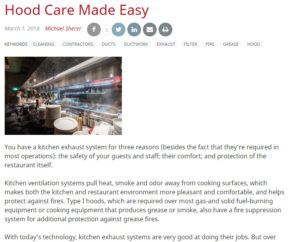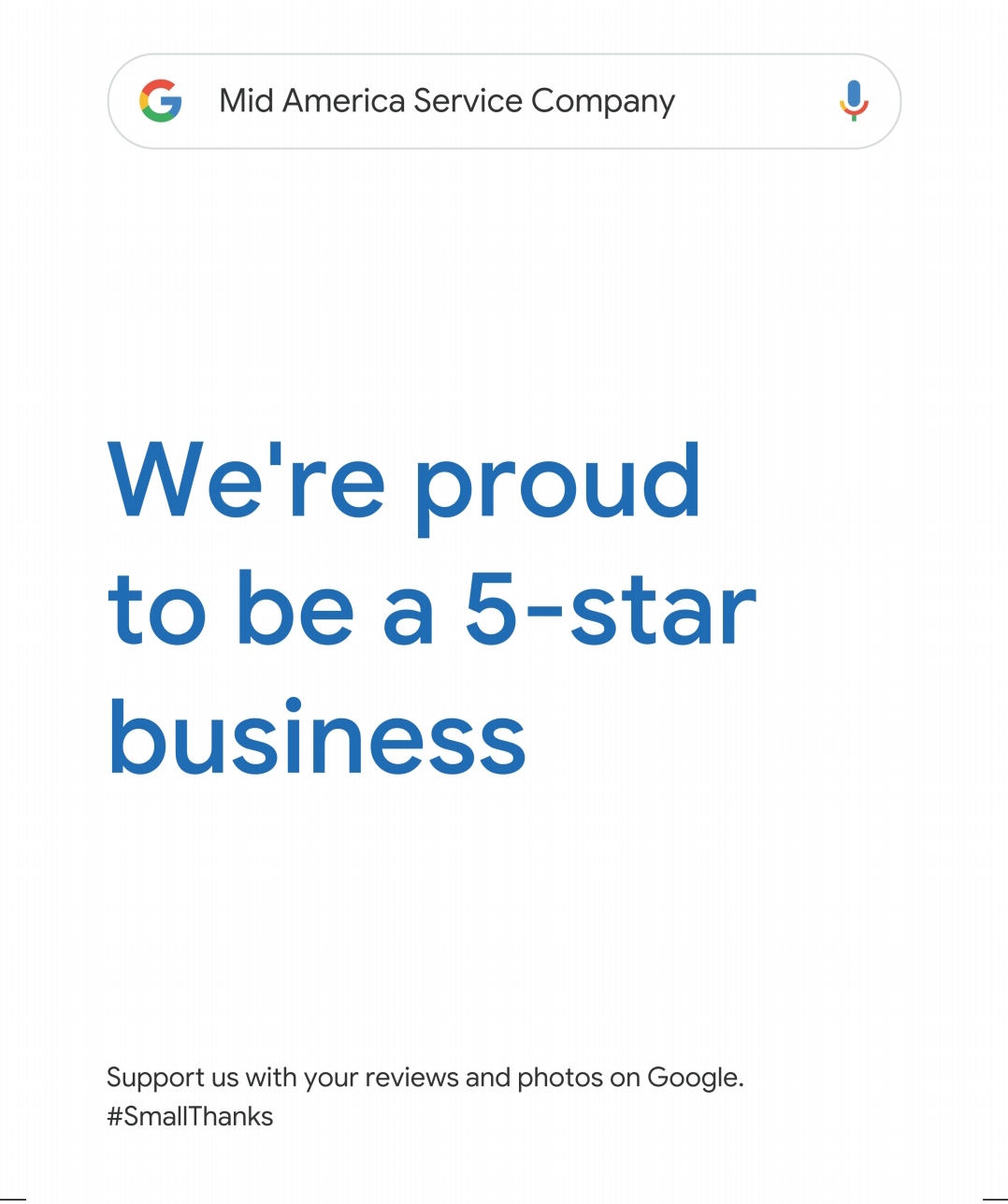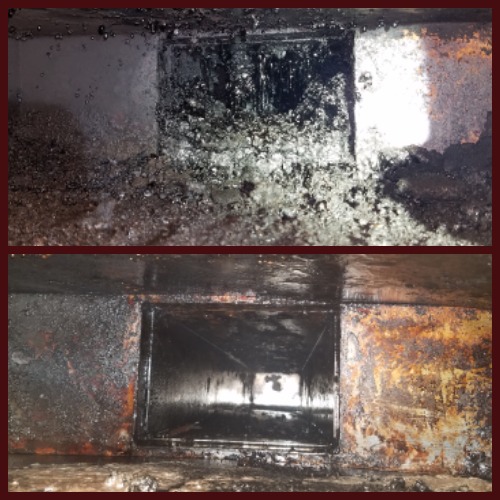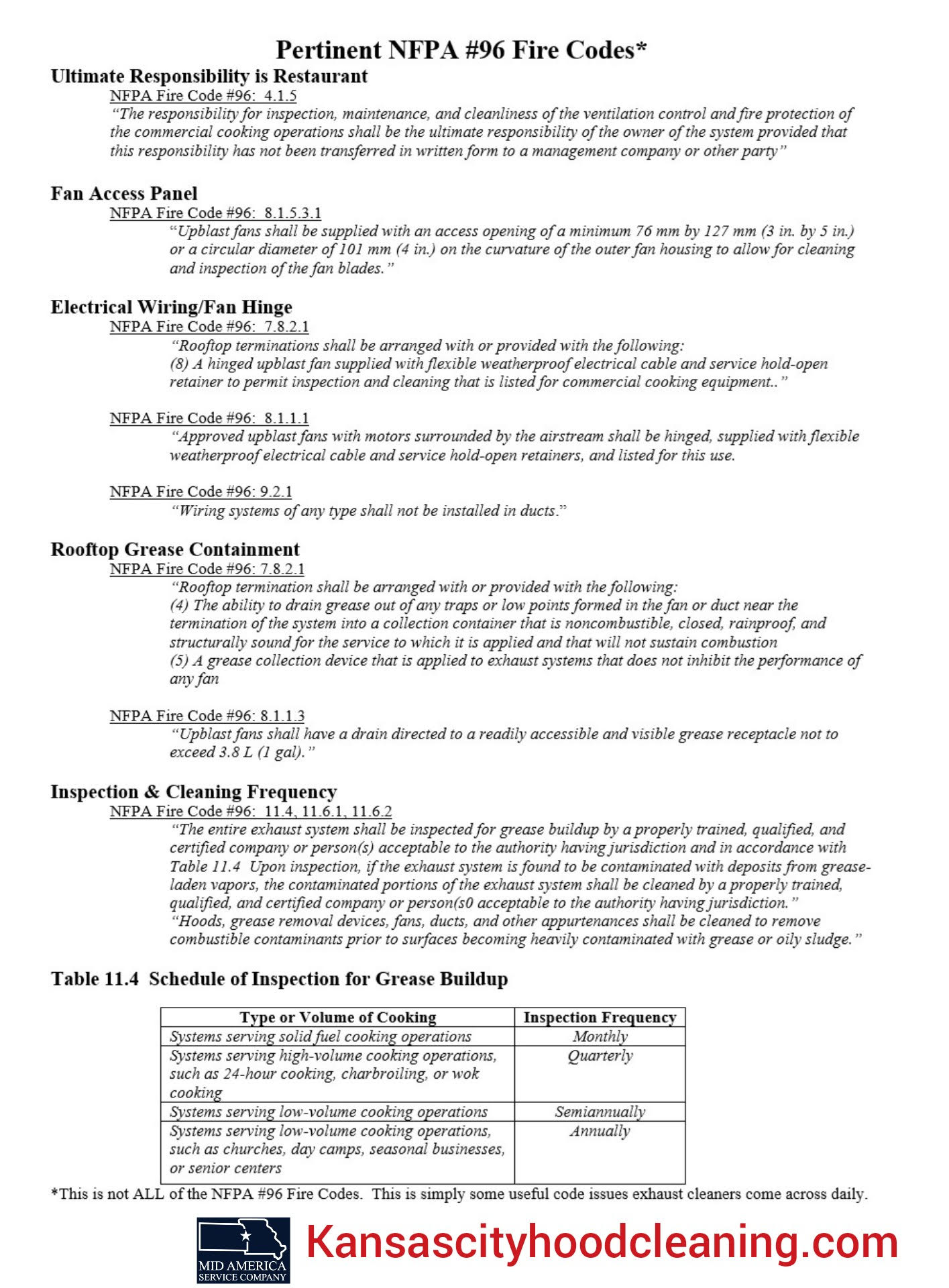We are super pleased to currently be rated 5 stars through Google. Although as most know in the service industry it’s very tough to please everyone. We will continue to put customers first,because without customers we would not exist. So Thank you to all of our customers, some of which we have serviced over 25 years.
Category Archives: Hood Cleaning
Inaccessible Ductwork Kansas City
Restaurant owners: is this your access to inaccessible ductwork? Code states that a worker needs to have room to work, or body access, to an access panel. Most times ductwork is installed prior to electrical, HVAC, gas lines, lightning, etc. Inaccessible areas in ductwork are against NFPA 96 code. This creates a fire hazard. Call us to help solve this issue for you.
Fire prevention 101: The basics on restaurant fire safety
Restaurants—with their open flames, hot equipment, electrical connections, cooking oils, cleaning chemicals and paper products—have all the ingredients for a fire to flame out of control. Nearly 8,000 eating and drinking establishments report a fire each year, according to 2006-2010 data tabulated by the National Fire Protection Association (NFPA) in Quincy, Mass. These fires caused an annual average of $246 million in direct property damage.
A fire can devastate your business, leading to lost revenues and even permanent closure. But there are steps you can take to prevent fires and minimize the damage.
Preventative maintenance
- Install an automatic fire-suppression system in the kitchen. This is crucial because 57% of restaurant fires involve cooking equipment. These systems automatically dispense chemicals to suppress the flames and also have a manual switch. Activating the system automatically shuts down the fuel or electric supply to nearby cooking equipment. Have your fire-suppression system professionally inspected semiannually. The manufacturer can refer you to an authorized distributor for inspection and maintenance.
- Keep portable fire extinguishers as a backup. You’ll need Class K extinguishers for kitchen fires involving grease, fats and oils that burn at high temperatures. Class K fire extinguishers are only intended to be used after the activation of a built-in hood suppression system. Keep Class ABC extinguishers elsewhere for all other fires (paper, wood, plastic, electrical, etc.).
- Schedule regular maintenance on electrical equipment, and watch for hazards like frayed cords or wiring, cracked or broken switch plates and combustible items near power sources.
- Have your exhaust system inspected for grease buildup. The NFPA Fire Code calls for quarterly inspections of systems in high-volume operations and semiannual inspections in moderate-volume operations. Monthly inspections are required for exhaust systems serving solid-fuel cooking equipment, like wood- or charcoal-burning ovens.
Staff training
Train your staff to:
- Find and use a fire extinguisher appropriately. An acronym you may find helpful is PAST – pull out the pin, aim at the base, make a sweeping motion, (be) ten feet away.
- Clean up the grease. Cleaning exhaust hoods is especially important, since grease buildup can restrict air flow. Be sure to also clean walls and work surfaces; ranges, fryers, broilers, grills and convection ovens; vents and filters.
- Never throw water on a grease fire. Water tossed into grease will cause grease to splatter, spread and likely erupt into a larger fire.
- Remove ashes from wood- and charcoal-burning ovens at least once a day. Store outside in metal containers at least 10 feet from any buildings or combustible materials.
- Make sure cigarettes are out before dumping them in a trash receptacle. Never smoke in or near storage areas.
- Store flammable liquids properly. Keep them in their original containers or puncture-resistant, tightly sealed containers. Store containers in well-ventilated areas away from supplies, food, food-preparation areas or any source of flames.
- Tidy up to avoid fire hazards. Store paper products, linens, boxes and food away from heat and cooking sources. Properly dispose of soiled rags, trash, cardboard boxes and wooden pallets at least once a day.
- Use chemical solutions properly. Use chemicals in well-ventilated areas, and never mix chemicals unless directions call for mixing. Immediately clean up chemical spills.
Be prepared: Have an emergency plan
If a fire breaks out in your restaurant, your staff must take control of the situation and lead customers to safety.
- Be prepared to power down. Train at least one worker per shift how to shut off gas and electrical power in case of emergency.
- Have an evacuation plan. Designate one staff member per shift to be evacuation manager. That person should be in charge of calling 911, determining when an evacuation is necessary and ensuring that everyone exits the restaurant safely. Ensure your staff know where the closest exits are, depending on their location in the restaurant. Remember that the front door is an emergency exit.
- Offer emergency training. Teach new employees about evacuation procedures and the usage of fire-safety equipment. Give veteran staff members a refresher course at least annually.
Important NFPA 96 Codes
Fire Codes Every Restaurant in Kansas City Should Know
The National Fire Protection Association (NFPA) is the authority on fire, electrical and building safety. The association has established Fire Code #96 with various expectations that restaurants are required to comply with.
Main causes of restaurant fires and the codes that relate to them
Cooking causes 59 percent of restaurant fires. Nearly all of these types of fires are small and contained, resulting in limited damage. Cooking fires may be caused by failure to keep up with exhaust system inspection and cleaning. Hood filters and spark arrestor filters above stoves, deep fat fryers or open fired grills can be fire hazards if not cleaned regularly. Fans and ducts can also collect grease over time. The codes relating to these problems include:
- 11.4, 11.6.1 and 11.6.2: These state that a certified exhaust system cleaner must inspect the area regularly for grease buildup. If the area contains oily sludge, it must be cleaned. Removable parts must be cleaned regularly before they become heavily contaminated with grease or oil.
Specific hood filters and spark arrestor filters are required in commercial kitchens. The relevant codes include:
- 6.1, 6.2 and 14.5: Grease filters must be UL-listed and made of steel or another rigid material. Mesh filters aren’t good enough, unless they are used in conjunction with another UL-listed filter. Spark arrestor filters are also required for solid fuel cooking operations to minimize the entrance of sparks and embers into the grease filter.
Electrical malfunctions cause about 8 percent of all restaurant fires. To prevent these, the following fire codes exist:
- 7.8.2.1, 8.1.1.1 and 9.2.1: These address the condition of rooftop terminations. The codes state that upblast fans should be hinged and wiring systems should be weatherproof and flexible. Wiring should also never be installed in ducts, and service hold-open retainers should be present to allow for easy inspection and cleaning of materials on the roof.
Rooftop grease containment is another concern. The following fire codes are in place to combat fires on the roof:
- 7.8.2.1 and 8.1.1.3: The grease collection device and draining system should be noncombustible, closed, rainproof and structurally sound. The upblast fan should include a way to drain grease into a visible receptacle no more than one gallon in volume.
What a restaurant owner needs to do to stay safe
Even though 74.3 percent of all restaurant building fires remain confined to the equipment that started them and do very little harm to the building or the people inside, it’s important to take precautions against restaurant fires with these tips:
- Install smoke alarms in the kitchen as well as throughout the building.
- Install a partial or fully automated extinguishing system, such as sprinklers.
- Clean hood filters regularly. Hire a professional kitchen exhaust cleaner and schedule monthly cleanings for solid fuel cooking operations or quarterly for high-volume, non-solid fuel burning cooking operations.
- Install a large enough duct access panel (3 inches by 5 inches square or a 4-inch diameter circle) to make cleaning the ductwork interior possible. After all, if you can’t see it, you can’t clean it.
Important NFPA 96 codes pertaining to restaurant owners and managers in Kansas City.
Hood Care Made Easy
Hood care made easy.. a very informative article for those in a position to choose a hood cleaning provider…
 “You have a kitchen exhaust system for three reasons (besides the fact that they’re required in most operations): the safety of your guests and staff; their comfort; and protection of the restaurant itself.
“You have a kitchen exhaust system for three reasons (besides the fact that they’re required in most operations): the safety of your guests and staff; their comfort; and protection of the restaurant itself.
Kitchen ventilation systems pull heat, smoke and odor away from cooking surfaces, which makes both the kitchen and restaurant environment more pleasant and comfortable, and helps protect against fires. Type I hoods, which are required over most gas-and solid fuel-burning equipment or cooking equipment that produces grease or smoke, also have a fire suppression system for additional protection against grease fires.”









